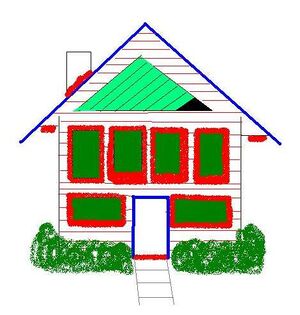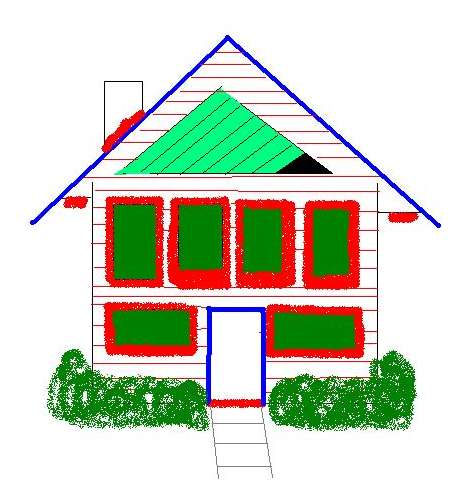
The basic idea is to use the appropriate insulation within your home to save on heating and cooling costs. There are easy fixes and many new technologies in insulation that will prevent thermal loss year round. The expenses might seem high but will be able to pay for themselves in years and create a more energy efficient environment. This article will discuss the different options and procedures available.
Physics Principles of Insulation[edit | edit source]
Building Materials[edit | edit source]
Insulators
- Choice ones that "retard the flow of heat from one object to another"
- High "resistance to heat transfer
- Porous Materials are Great Insulators - This is due to the air in the pores acts as a "Good insulator"
- Choose darker objects = better emitter and absorber
- Darker objects > absorber/emitter than white
- Thermos = bottle inside a bottle - Device to reduce heat transfer - 2 bottles separated by a vacuum = > heat transfer from to inside chamber
Types of Insulation[edit | edit source]
4 BASIC TYPES OF INSULATION
Loose-fill Insulation
- Materials included in:
- loose fibers or fiber pellets
- Made of Cellulose fibers chemically treated to be moisture and fire resistent
- Fiberglass and Rock Wool = [Blow-in Blanket System] (BIBS)
- cost more then batt insulation
- Benefits/Positives
- Fills small cracks/crevices easier
- Reduces air Leakage better
- Better sound reducer (then batt insulation)
- R-3 to R-4 value per inch
- Cellulose fiber > (by 30%) then loose-fill rock wool
Batt and Blanket Insulation
- Materials Include:
- Made of Mineral Fibers (fiberglass or rock wool)
- Benefits/Positives
- Least expensive wall insulation material
- Best for Standard joist/rafters/studs
- Build in radiant barrier backing
- Come in long rolls that can be cut to desired length
- R-value of Approximately R-3 per inch thickness
Rigid Board Insulation
- Materials Include:
- Made from fiberglass, polystyrene, or polyurethane
- Benefits/Positives
- Come in variety of thicknesses
- R-value is the HIGHEST = R-4 to R-8 per inch
- Uses
- Reproofing work on flat roofs
- Basement Walls
- Perimeter insulation at concrete slab edges
- Cathedral Ceilings
- Must be covered with 1/2 inch gypsum board in used inside
- Must be covered with Weather-proof facing if used exteriorly
- Uses
- Insulate below floors, above ceilings, and within walls
Spray Foam Insulation
- Materials include:
- Two-part liquid containing polymer and foam agent
- Uses
- Sprayed on Wall, ceiling, and floor cavities
- Expands to sold cellular plastic with many air cavities
- Good for irregular shaped areas and around obstructions
- Negatives
- Require specific machinery to spray/mix
If you need help determining the type of insulation, consult a contractor or try this site: http://web.archive.org/web/20130616194144/http://www.ornl.gov/sci/roofs+walls/insulation/ins_08.html
US natural insulation comparison will also provide a good comparison of natural insulation for your benefit.
Proper Procedures[edit | edit source]
- Monitor your energy usage form year to year
- Call Local Power Company/Contractor about an energy audit
- Measure depth of insulation between joists in attic if unheated
- Re-caulk windows, doors, siding, dampers, vents
Insulating
- Replace insulation with newer/more appropriate insulation for area
- Add vapor barrier to all exterior walls
- If insulating the floors above an unheated basement, place insulation facing toward floor
- To insulate your basement use rigid insulation boards.
Improving Insulation
| Northern Zone | Temperate Zone | Southern Zone | |
|---|---|---|---|
| Attic | R38 | R30 | R26 |
| Walls | R19 | R19 | R19 |
| Floors | R22 | R13 | R11 |
Helpful tips from Black and Decker
- Install a vapor barrier of 6-mil polyethylene on the warm-in-winter side of the insulation.
- Insulate the rim joists at the top of the foundation walls by filling them loosely with fiberglass insulation.
- Insulate an attached garage with faced fiberglass insulation, with the vapor barrier facing into the garage.
- Don't compress insulation to fit: it needs air space to work effectively.
In the Attic
- Prevent heat loss hear by adding a second layer of insulation over the joists = Attic Blanket
- Insulate the rim joists at hte top of your foundation walls by filling them loosely with fiberglass insulation.
Materials[edit | edit source]
Estimated Costs (Energy and It's Uses in the Environment)
- Increased Insulation = save as much as 50% on heating/cooling bills
- Federal Minimum Property Standards could be reached nationwide is everyone saved at least 15% of current heating demand.
- -The minimum insulation recommendations are currently
- Ceilings have to now have a R value of 66, not the previous 19
- Wall's R value should be 66, instead of the previous 11.
- Floors should have a 32 R value, instead of the previous 22.
Thermal Resistance = R value
- Physics behind this can be found by clicking on the word
(This was complete for an exam review in my PH261 class)
- Given by thickness/material's thermal conductivity (delta/k).
- Higher R-value = better insulating properties
- Given by thickness/material's thermal conductivity (delta/k).
R-Values Per Inch For Common Insulating Materials*
- --For a broader table please follow this external link http://www.coloradoenergy.org/procorner/stuff/r-values.htm
| Material | Thickness | R-Value |
|---|---|---|
| Hard wood | 1" | 0.91 |
| Plywood | 1/2" | 0.62 |
| Wood siding | 1/2" | 0.81 |
| Asphalt roofing Shingle | .44 | |
| Fiberglass insulation | 3 1/2" | 10.9 |
| Fiberglass insulation | 6" | 19.0, but in stud wall, 16" spacing, nets R=11 |
Example in Wall Values
- Combination of various materials = greater R value = greater insulation and > energy (heat/cooling) loss
- R for a typical wall has siding, plywood, fiberglass insulation, and plasterboard
Things that Affect R value
- Location
- "Convective resistance depends strongly on the velocity of the air moving along the surface." All previous values are for areas with 10mph winds.
- "If the wind velocity increases to 15mph, the.2 R-Value of the 1/16" air film is decreased by 50% to.1, insignificant for walls, major for bare skin.
- ANSWERS TO SOLVING SUCH PROBLEMS
- Plant trees and shrubs near house to reduce wind effects.
Common mishaps when insulating your own home[edit | edit source]

- AIR LEAKS
- Unsealed gaps around: Joists, sills, windows, no weather stipping around doors,
Exterior Vents (Water Connections, Kitchen/Bathroom Vents, Dampers/vents)
- Cracks in Foundation/Walls/Chimneys
- Poorly fitted Air Barriers in Walls: Attach Hatches and Wall outlets
- Spreading Insulation Too THIN
- Using the Wrong type of Insulation
- NOT Insulating Your Whole House(Attic,Basement, Vents, Doors)
- NOT Using Weatherizing Materials
- Letting Fiberglass Irritate your skin. (WEAR PANTS/LONG SLEVE CLOTHING and change clothing proptly.)
- REPLACE YOUR WINDOW (Large loss of heat can occur here!!)
- Allow Your Wood to Dry completely before adding Weatherizing Material or Moisture Resistant Materials
References[edit | edit source]
- Hinrichs and Kleinbach. "Energy It's Use and the Environment" 3rd Edition. Thomson Learning, New York, NY 2002.
- Almost any HOW TO BOOK. I love the Black and Decker Complete Photo Guide to Home Repair. It contains a basic background and visual step by step procedure.
- "Energy Efficient Rehab Advisor" <http://web.archive.org/web/20130808220554/http://rehabadvisor.pathnet.org:80/sp.asp?id=10783>
See also[edit | edit source]
External links[edit | edit source]
Useful Government Web Sites
- US Department of Energy http://www.eere.energy.gov/
Grants to Fund Your New Project
- Energy Grants for Homeowners http://web.archive.org/web/20161014210534/http://www.elements.nb.ca:80/theme/building/energuide/grants.htm
[edit | edit source]
First browse the articles and subcategories below for examples and possible collaborations. Type a proposed name for the project, organization, thesis, how to or other related resource in the following create box.
Add information. Do not worry about formatting or completeness, others will help and changes are easily made. Be BOLD. TOGETHER WE CAN ACHIEVE MORE!! LET"S ALL SHARE OUR KNOWLEDGE and like my physics professor suggests, add on information so we can all unite! Such topics could be
- Caulking Procedures
- Windows
- Dampers
- Heating Systems